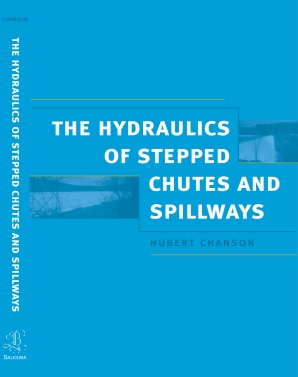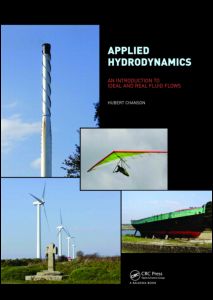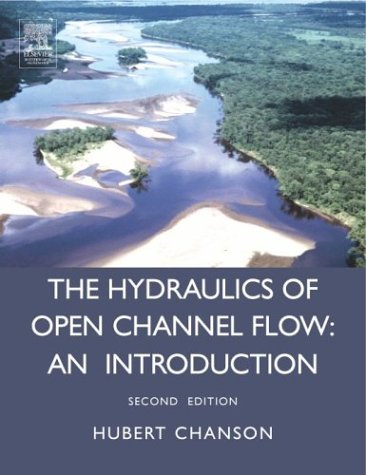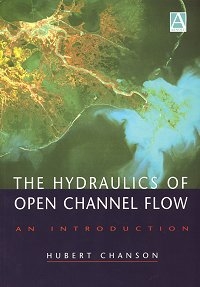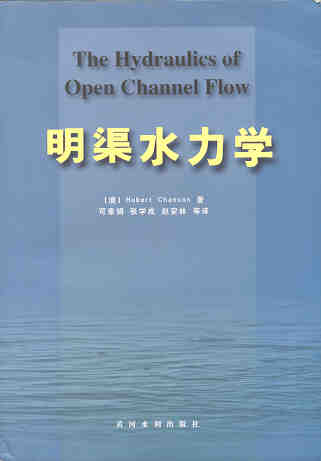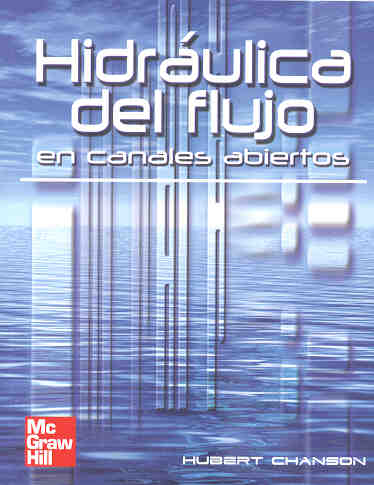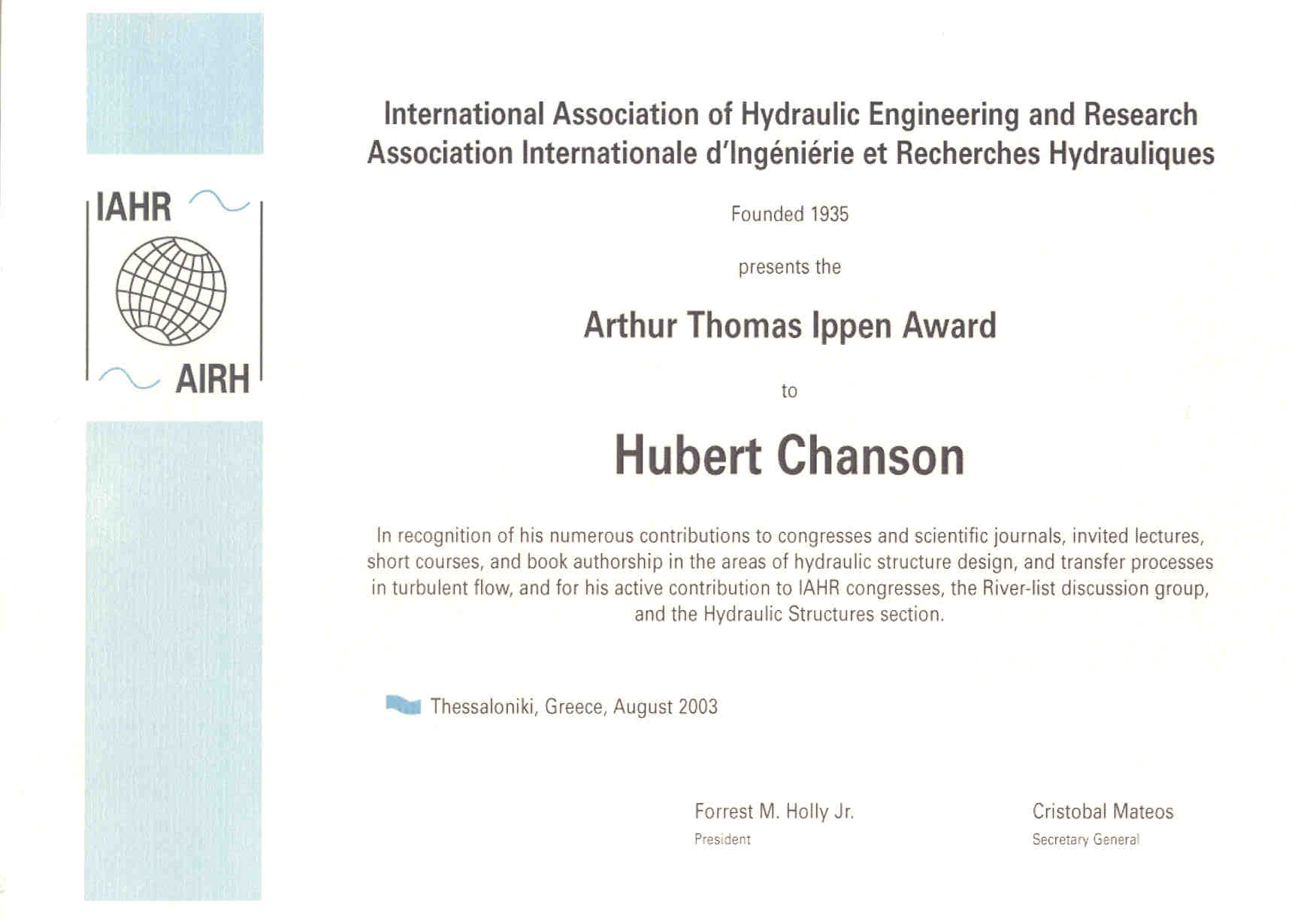
Hubert Chanson
(h.chanson@uq.edu.au)
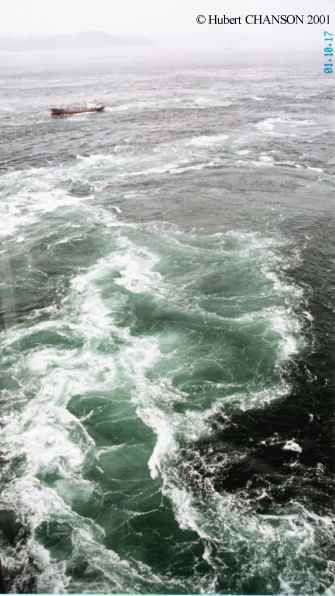
Biography
(up to 2003)
Hubert Chanson was born
on 1 November 1961 in Paris, France. He leaves in Brisbane, Australia,
with his wife Ya-Hui (Karen) Chou and their children Bernard, Nicole
and André.
Hubert Chanson received a degree of 'Ingénieur Hydraulicien'
from the Hydraulic
Engineering School of Grenoble, France (ENSHMG)
in 1983 and a postgraduate
degree of 'Ingénieur Génie Atomique' from the Nuclear
Engineering Institute of Saclay (INSTN) in 1984. He worked for the
industry in France as a R&D engineer at the Atomic Energy
Commission from 1984 to 1986, and as a computer professional in fluid
mechanics for
Thomson-CSF between 1989 and 1990. From 1986 to 1988, he studied at the
University of Canterbury
(New Zealand) as part of a Ph.D. project. He was awarded a Doctor
of
Engineering from the University
of Queensland in 1999 for outstanding research achievements in the
study of air-water flows. In 2003, the International Association
for Hydraulic engineering and Research (IAHR)
presented him the 13th Arthur Ippen award for
outstanding achievements in hydraulic engineering. This award is
regarded as the highest achievement in hydraulic research.
Hubert Chanson is a Professor in Civil Engineering, hydraulic engineering and environmental fluid mechanics, at the University of Queensland (Australia). His research interests include open channel flows and hydraulic structures, fluid dynamics of two-phase flows, applied hydrodynamics, water quality modelling, engineering history, environmental fluid mechanics and natural resources. He is the author of sixteen books including : "Hydraulic Design of Stepped Cascades, Channels, Weirs and Spillways" (Pergamon, 1995), "Air Bubble Entrainment in Free-Surface Turbulent Shear Flows" (Academic Press, 1997), "The Hydraulics of Open Channel Flows : An Introduction" (Butterworth-Heinemann, 1999), "The Hydraulics of Stepped Chutes and Spillways" (Balkema, 2001), "Applied Hydrodynamics: an Introduction of Ideal and Real Fluid Flows" (CRC Press, 2009), and "Tidal Bores, Aegir, Eagre, Mascaret, Pororoca: Theory And Observations" (World Scientific, 2011). His publication record includes over 600 international refereed papers and his work was cited more than 3,500 times for the period 1988-2012. Professor Chanson has been also active as a consultant for both governmental agencies and private organisations, in Australia and overseas.
He has been awarded six fellowships from the Australian Academy of Science. In 1995 he was a Visiting Associate Professor at National Cheng Kung University (Taiwan R.O.C.) and he was a Visiting Research Fellow at Toyohashi University of Technology (Japan) in 1999, 2001 and 2008. He was the keynote lecturer at numerous events, including the 1998 ASME Fluids Engineering Symposium on Flow Aeration, at the Workshop on Flow Characteristics around Hydraulic Structures (Nihon University, Japan 1998), at the 1st International Conference of the International Federation for Environmental Management System IFEMS'01 (Japan, 2001), more recently the 2nd International Conference on Coastal Zone Engineering and Management (Arabian Coast 2010) (Oman 2010), NSF Partnerships for International Research and Education (PIRE) Workshop on “Modelling of Flood Hazards and Geomorphic Impacts of Levee Breach and Dam Failure" (Auckland 2012).. Hubert Chanson gave numerous invited lectures and he lectured several short courses in Australia and overseas (e.g. Taiwan, France, Italy, Japan).
Member of the IAHR since 1990, Hubert Chanson contributes actively to the IAHR activities during the Biennial congresses, in the River-list discussion group, through the IAHR newsletter (No. 2, No. 3). He has been actively involved in the Hydraulic Structures Section (Technical Division Applied Hydraulics) since inception; he has been a reviewer for the Journal of Hydraulic Research and numerous IAHR congresses, as well as for other pro-eminent journals : e.g., Journal of Fluid Mechanics, Physics of Fluids, Journal Hydraulic Engineering ASCE, Chemical Engineering Science, Journal of Fluids Engineering ASME, International Journal of Multiphase Flow, Canadian Journal of Civil Engineering, Journal La Houille Blanche. Knowing Dr Chanson's energy, a forthcoming IAHR Congress might soon be held in Brisbane, Australia. He chaired the Organisation of the 34th IAHR World Congress held in Brisbane, Australia in June 2011. The event jointly organised by Engineers Australia and IAHR attracted over 820 participants from 45 countries. The congress proceedings papers were peer-reviewed thoroughly and a total of 587 papers were published in the proceedings out of 840 full paper submissions and 1,400 abstract submissions.
During his career, Hubert Chanson has been stimulated by the indispensable interactions between professionals, researchers and educators. He believes that high-quality research does improve teaching by providing University’s graduates with state-of-the-art expertise as well as enhancing the professional knowledge to the benefits of the society. A key feature of his achievements is the very-strong interactions between his research, teaching and service to the community. An example is his work on stepped channel hydraulics. Much research derived from his teaching activities initiated in 1992 both at undergraduate and postgraduate levels, leading to the publication of books (Pergamon 1995, Balkema 2001) and numerous professional activities. Another example is his work on air bubble entrainment. His research activities have been associated with the training of several postgraduate and undergraduate research students, acknowledged in his book (Academic Press 1997, p. xvii). Basic results have been included in some teaching and in his undergraduate textbook (Butterworth-Heinemann, 1999). The book is used in over twenty universities and by numerous professionals. The translation of the text in Chinese (by IWHR) and Spanish (by McGraw-Hill Interamericana) demonstrates its international standing.
Hubert Chanson's work was influenced by three scholars : Professor
Colin J. Apelt, University of Queensland (Australia), Professor Ian R.
Wood, University of Canterbury (NZ), and Dr Jean-Marie Michel, ENSHM
Grenoble (France). He is indebted to their friendship and valuable
advice.
Five most significant publications (1990-2003)
CHANSON, H. (1997). "Air Bubble Entrainment in Free-Surface Turbulent Shear Flows." Academic Press, London, UK, 401 pages (ISBN 0-12-168110-6).
"Hubert Chanson has produced an excellent book. This is a great service to the profession." Professor I.R. WOOD, University of Canterbury (NZ) in Jl of Hyd. Engrg., ASCE, 1997.
CHANSON, H. (2001). "The Hydraulics of Stepped Chutes and Spillways." Balkema, Lisse, The Netherlands (ISBN 90 5809 352 2).
CHANSON, H. (1995). "Hydraulic Design of Stepped Cascades, Channels, Weirs and Spillways." Pergamon, Oxford, UK, Jan., 292 pages (ISBN 0-08-041918-6).
"This book contains a wealth of knowledge on these subjects. I can recommend it." Dr R.J. DE JONG, Delft Hydraulics (Hol.), in Jl of Hyd. Res., IAHR, 1996.
CUMMINGS, P.D., and CHANSON, H. (1997). "Air Entrainment in the
Developing Flow Region of Plunging Jets. Part 1 Theoretical
Development." Jl of
Fluids Eng., Trans. ASME, Vol. 119, No. 3, pp. 597-602. (download PDF
file)
CUMMINGS, P.D., and CHANSON, H. (1997). "Air Entrainment in the
Developing Flow Region of Plunging Jets. Part 2 : Experimental." Jl
of Fluids Eng., Trans. ASME, Vol. 119, No. 3, pp. 603-60. (download PDF
file)
Biography of Professor Arthur IPPEN
Arthur Thomas Ippen (1907-1974) was Professor in hydrodynamics and
hydraulic engineering at M.I.T.
(USA).
Born in London of German parents, educated in Germany (Technische
Hochschule in Aachen), he moved to USA in 1932, where he obtained the
M.S. and Ph.D. degrees at the California Institute of Technology. There
he worked on high-speed free-surface flows with Theodore von Karman. In
1945 he was appointed at M.I.T. until his retirement in 1973.
Born in London, England, of German parents on July 28, 1907, Arthur Ippen's engineering career began in Germany where he received his early education, graduating as Diplom-Ingenieur from the Technische Hochschule in Aachen in 1931. After a year as a teaching and research assistant in geodesy at Aachen, he came to the United States as an Exchange Fellow of the Institute of International Education, studying at the Institute of Hydraulic Research at the University of Iowa. In 1934 he transferred to the California Institute of Technology where he became a Teaching and Research Fellow in Hydraulics, earning the M.S. and Ph.D. degrees from that institution in 1935 and 1936, respectively. His research in high-speed free surface flows and his subsequent career in education were strongly influenced by his association there with Theodore von Karman.
After completing his Ph..D., Ippen spent two more years at the California Institute of Technology as a research engineer and Instructor in Hydraulics. In 1938 he joined the faculty of Lehigh University as an Instructor in Hydraulics and took charge of the reconstruction of the hydraulics laboratory. Appointed Assistant Professor in 1939, he continued in that capacity until 1945, when he joined the M.I.T. faculty as Associate Professor in the Department of Civil Engineering and Head of the Division of Hydraulics. He was promoted to full Professor at M.I.T. in 1948. When the hydraulic and sanitary engineering activities at M.I.T. were combined in 1961 to form the Division of Water Resources and Hydrodynamics, Ippen was placed in charge. He directed this new division until 1972, guiding its expansion into the new educational and research areas of water resource systems and environmental engineering until his formal retirement in 1973.
Throughout his career Ippen was active in international educational exchange. His most notable contribution in this field was the faculty exchange program between M.I.T. and the Technical University of Berlin, which he directed from its inception in 1964 until his death. He was also active in the M.I.T.-Ford Foundation cooperative program with the Birla Institute of Technology and Science in India and the Inter-American Program of the School of Engineering which focused on water resources development in South America. He also served as a lecturer and educational consultant in many countries, notably with the U.S.-Japan Cooperative Science Program and the Southeast Asia Treaty Organization (SEATO) Graduate School.
Arthur Ippen authored over one hundred professional articles, engineering reports, and other papers. He was also a member of numerous professional organizations and held many leading offices in them. His memberships include the International Association for Hydraulic Research (honorary member), the American Society for Engineering Education, the American Society of Civil Engineers (life member), the Boston Society of Civil Engineers (honorary member), the American Society of Mechanical Engineers, the American Geophysical Union, and the Japan Society of Civil Engineers (honorary member).
Acknowledgements : Professor Don HARLEMAN and MIT Library, Institute Archives and Special Collections.
Number of visitors since 09-June-2002 : xxxx
Last updated on 09/04/2012
|
|
|
Deposits at UQeSpace |
Back to Prof Hubert CHANSON's Home Page
